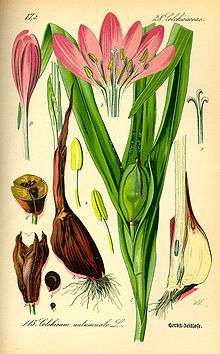Colchicum autumnale
| Colchicum autumnale | |
|---|---|
 | |
| Scientific classification | |
| Kingdom: | Plantae |
| (unranked): | Angiosperms |
| (unranked): | Monocots |
| Order: | Liliales |
| Family: | Colchicaceae |
| Genus: | Colchicum |
| Species: | C. autumnale |
| Binomial name | |
| Colchicum autumnale L.[1] | |
| Synonyms[2] | |
| |
Colchicum autumnale, commonly known as autumn crocus, meadow saffron[3] or naked lady, is an autumn-blooming flowering plant that resembles the true crocuses, but is a member of the Colchicaceae plant family, unlike the true crocuses which belong to the Iridaceae family. The name "naked lady" comes from the fact that the flowers emerge from the ground long after the leaves have died back.[4]
The species is commonly cultivated as an ornamental in temperate areas, in spite of its toxicity.
Distribution
Colchicum autumnale is the only species of its genus native to the Great Britain and Ireland,[5][6] with notable populations under the stewardship of the County Wildlife Trusts. It also occurs across mainland Europe from Portugal to Ukraine, and is reportedly naturalized in Denmark, Sweden, European Russia, the Baltic states and New Zealand.[2]
Pharmaceutical uses
The bulb-like corms of Colchicum autumnale contain colchicine, a useful drug with a narrow therapeutic index. Colchicine is approved by the US FDA for the treatment of gout and familial Mediterranean fever. Colchicine is also used in plant breeding to produce polyploid strains.
Toxicity
Colchicum plants are deadly poisonous due to their colchicine content, and have been mistaken by foragers for ramsons, which they vaguely resemble. The symptoms of colchicine poisoning resemble those of arsenic, and no antidote is known.
Gallery
- Flowers surrounded by other plants
 Two flowers
Two flowers Seed capsules
Seed capsules- Seeds
 Colchicum autumnale by Auguste Faguet
Colchicum autumnale by Auguste Faguet- After the rain
 Detail of flower at the United States Botanic Gardens
Detail of flower at the United States Botanic Gardens Colchicum autumnale Limana, (Valmorel), Italy
Colchicum autumnale Limana, (Valmorel), Italy Several Colchicum autumnale in a meadow Lauterbourg, (Alsace), France
Several Colchicum autumnale in a meadow Lauterbourg, (Alsace), France
References
- ↑ Linnaeus, Carl von. 1753. Species Plantarum 1: 341, Colchicum autumnale
- 1 2 Kew World Checklist of Selected Plant Families, Colchicum autumnale
- ↑ "BSBI List 2007". Botanical Society of Britain and Ireland. Archived from the original (xls) on 2015-01-25. Retrieved 2014-10-17.
- ↑ Gajic. 1977. Glasnik prirodnaučkog museja u Beogradu, Serija B, Bioloake nauke Nauke 32: 8. Colchicum autumnale
- ↑ Clapham, A.R., Tutin, T.G. and Warburg, E.F. 1968. Excursion Flora of the British Isles. Cambridge. ISBN 0-521-04656-4
- ↑ Parnell, J. and Curtis, T. 2012. Webb's An Irish Flora. Cork University Press. ISBN 978-185918-4783
Further reading
| Wikimedia Commons has media related to Colchicum autumnale. |
- Autumn Bulbs by Roy Leeds (B.T. Batsford Ltd) 2006 ISBN 0-7134-8962-6
- Brvar, Miran; Ploj, Tom; Kozelj, Gordana; Mozina, Martin; Noc, Marko; Bunc, Matjaz (2004). "Case report: fatal poisoning with Colchicum autumnale". Critical Care. 8 (1): R56–9. PMC 420069
 . PMID 14975056. doi:10.1186/cc2427.
. PMID 14975056. doi:10.1186/cc2427.